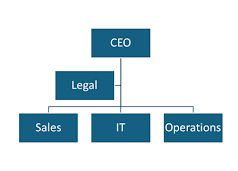Cybersecurity And Leadership: Part 1, We Mean All Leaders
All of these knee-jerk
reactions are wrong in different ways.
In this series we will explore what every leader's responsibility is for cybersecurity at the level of leadership they hold. Our position is that cybersecurity is everyone's business, and when we're talking business, we're talking about leaders and leadership.
Let's start by outlining who is
a leader in any typical organization. Your organization/company might call
these roles different things but that's window-dressing.
Board member: someone who has responsibility for
overseeing the performance of executives, and whose own job involves having
broad awareness of corporate goals, strategies, investment opportunities,
external environmental and political trends, etc.
In terms of cybersecurity, the
Board holds executives responsible for creating and maintaining growth or meeting mission goals.
Cybersecurity lapses impede the growth or mission of the corporation.
Executive: someone with fiduciary responsibility
for the performance of the organization. This might be a "Chief"
something (CIO, CTO, CEO, etc.). The executive has technical expertise and
responsibility that require her/him to adjudicate relative investments within
the corporation, assess the performance of the person's area of responsibility,
and correct as needed. Executives develop strategy and assign goals to
managers.
In terms of cybersecurity,
executives are responsible for creating and maintaining growth, which could
include revenue growth and accomplishment of mission. Cybersecurity lapses
impede the growth or mission of the corporation, while over-investing in
cybersecurity
may not improve the corporation's performance.
Middle manager/function
manager/project manager/etc.: someone whose performance is managed, and who is rewarded or
held accountable, for the performance of a specific function within the
organization. This manager has subordinate managers or subject matter experts
who report to her/him. Their significant expertise is a plus (though they can
be a "senior-doer") and they can set direction with input/approval
from executives to make investments in specific areas. Key aspects of middle
management are that they must accomplish goals given to them by executives and
they must collaborate with other middle managers. This is the level where "organiazitonal politics" becomes an issue. Performance is tracked
through reference to key performance indicators (KPIs).
In terms of cybersecurity,
managers are accountable for accomplishing KPIs. Cybersecurity lapses impede
the growth or mission of the corporation, while over-emphasizing cybersecurity
may be good for one are but less relevant for others and thus be impolitic.
Supervisor: someone whose entire job revolves around
getting individual contributors to complete assigned tasks on time and under
budget to the specified degree of quality, while also not engaging in counterproductive behavior. The supervisor position
is a rung on the corporate ladder for many. Others stall there due to the "Peter
Principle" (people promoted to the level of their incompetence). Getting tasks accomplished through others is good prep for executive
work, just at a lower level. But it also demands oversight vigilance that
should monitor for cybersecurity in addition to task performance.
In terms of cybersecurity,
supervisors are accountable for monitoring and documenting cybersecurity
violations, lapses in protocol, and counterproductive work behavior (we discuss
that in BARC).
In subsequent posts we'll
discuss in greater depth how each level of management has a role in cybersecurity. As always, ask us how we can help you align your leadership approaches with a cybersecurity focus.


Comments
Post a Comment